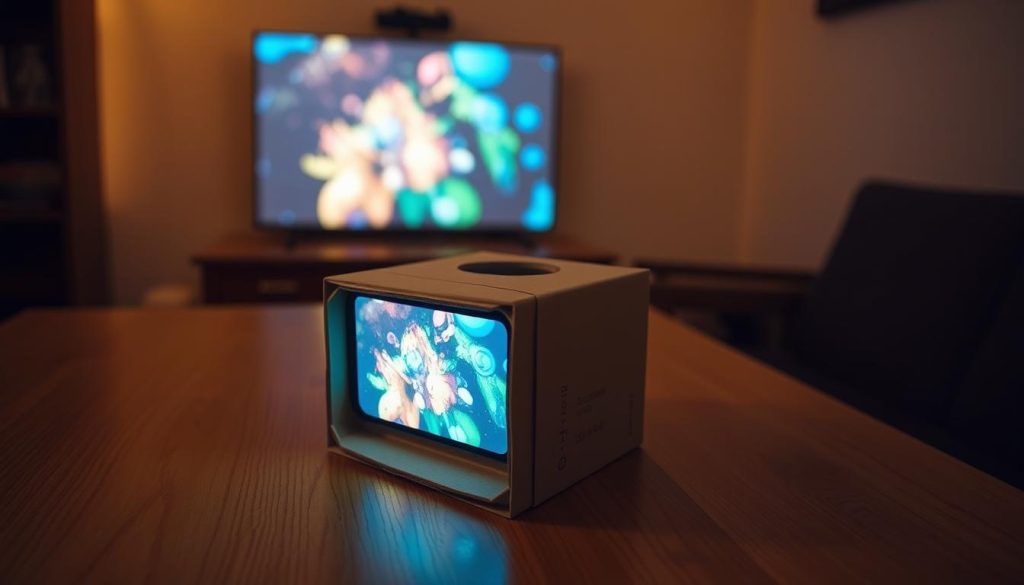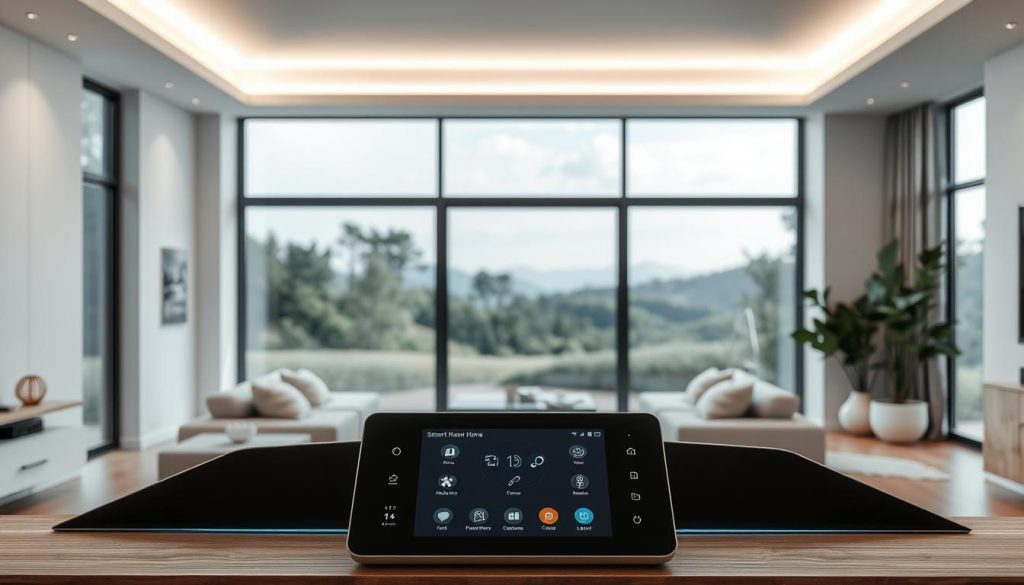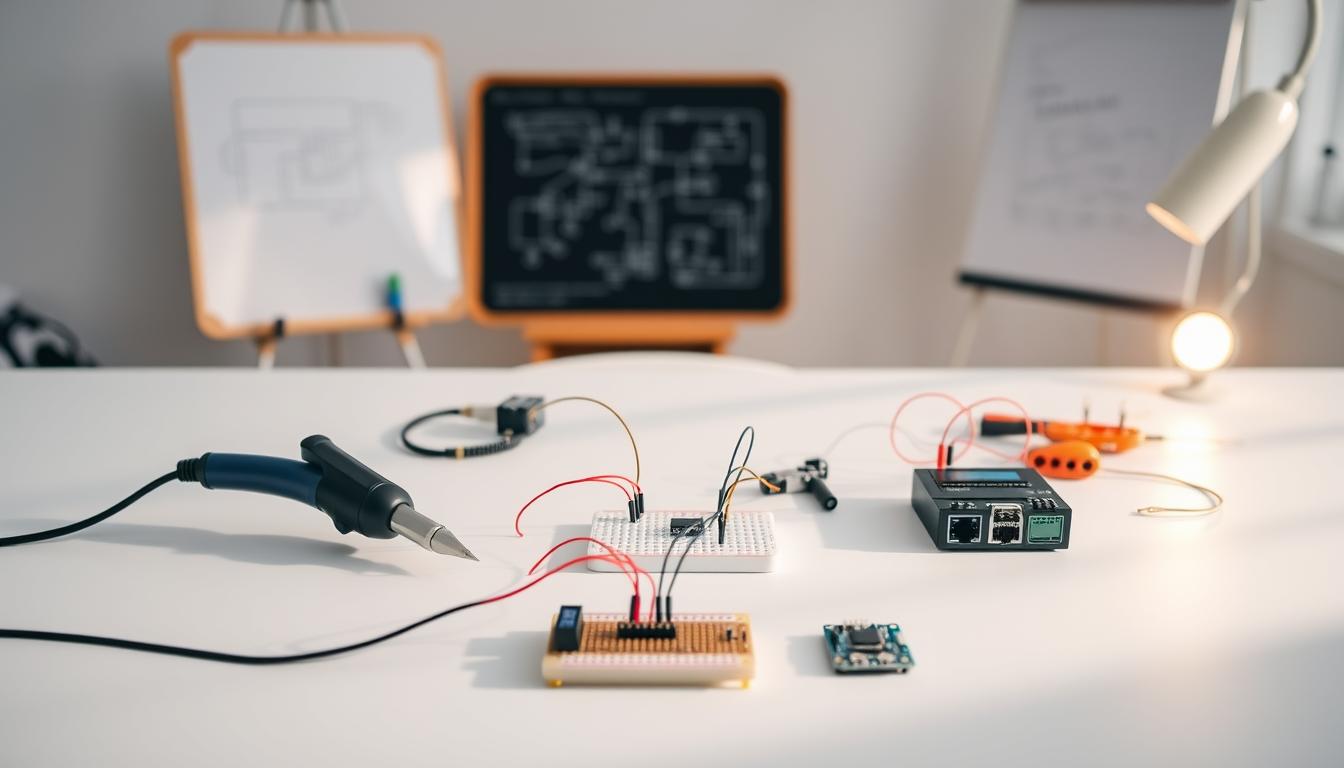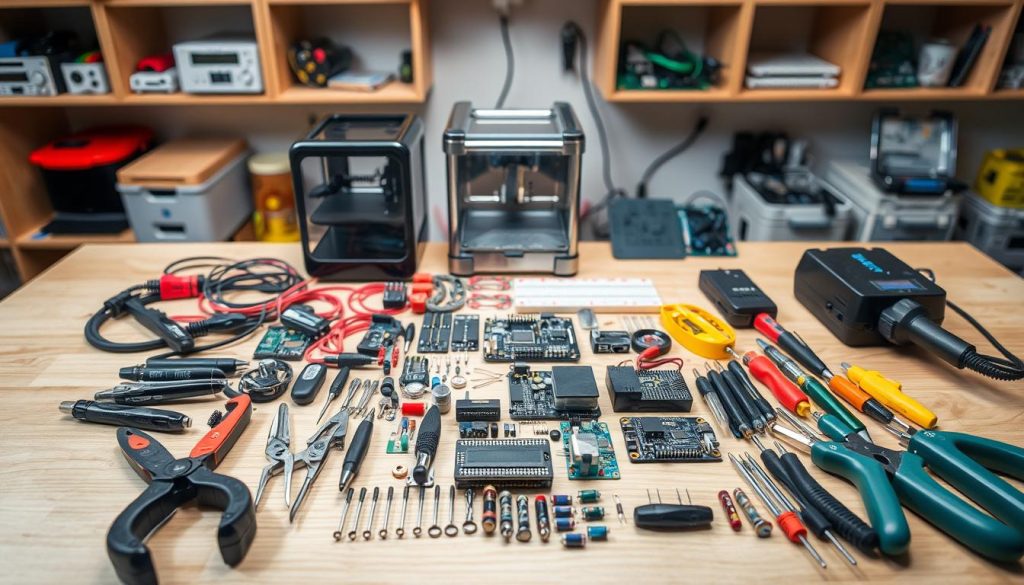Are you curious about diving into the world of technology but don’t know where to start? Exploring DIY tech projects can be a great way to spark your creativity and enhance your technical skills.
Starting with easy tech projects allows beginners to build confidence and gradually move on to more complex tasks. It’s an exciting journey that combines innovation with practical skills, making it a fulfilling hobby.
Engaging in beginner tech projects not only enhances your understanding of technology but also opens up new possibilities for creativity and innovation. It’s a great way to learn by doing and to achieve a sense of accomplishment.
Key Takeaways
Table of Contents
- Discover the benefits of starting with simple DIY tech projects.
- Learn how to build confidence in your technical skills.
- Explore the creative possibilities through tech projects.
- Understand the importance of hands-on experience in tech.
- Find resources to get started with beginner-friendly projects.
Why DIY Tech Projects for Beginners Are Worth Your Time
Beginners can greatly benefit from simple tech projects, which serve as a foundation for more complex DIY technology projects. Engaging in these projects not only fosters creativity but also equips individuals with the skills necessary to navigate today’s technology-driven world.
Building Valuable Skills for the Digital Age
By undertaking tech project ideas, beginners can develop a range of valuable skills, from programming and electronics to problem-solving and critical thinking. These skills are not only useful for personal projects but also highly valued by employers in the tech industry.
Cost-Effective Ways to Customize Your Tech
DIY tech projects offer a cost-effective way to customize technology to suit individual needs. Whether it’s modifying a gadget or creating a new device from scratch, beginners can learn to tailor technology to enhance their daily lives.
By starting with simple projects, beginners can build confidence and gradually move on to more complex DIY technology projects, enhancing their skills and customizing their tech in the process.
Essential Tools and Materials for Tech DIY
Embarking on DIY tech projects requires a foundational understanding of the essential tools and materials needed. Having the right equipment not only makes the process smoother but also ensures safety and enhances the overall experience.
Basic Electronics Toolkit
A basic electronics toolkit is the backbone of any DIY tech project. This typically includes a soldering iron, wire cutters, pliers, and a multimeter. These tools are indispensable for tasks such as circuit building and component testing.
Additionally, having a variety of connectors, resistors, and capacitors on hand can be very useful. These components are fundamental to creating and customizing electronic circuits.
Where to Source Affordable Components
Finding affordable components is crucial for keeping project costs manageable. There are several options both online and locally.
Online Resources
Websites like Adafruit, Amazon, and eBay offer a wide range of electronics components. These platforms often have customer reviews and detailed product descriptions, making it easier to select the right parts.
Local Options
Local electronics stores and hobby shops can be great resources for finding components. They often carry a selection of basic electronics tools and parts, and the staff may offer valuable advice.
| Tool | Use | Average Cost |
|---|---|---|
| Soldering Iron | Joining components | $20-$50 |
| Multimeter | Measuring voltage, current, and resistance | $15-$30 |
| Wire Cutters | Cutting wires to size | $5-$10 |
By equipping yourself with the right tools and materials, you’ll be well-prepared to tackle a variety of DIY tech projects. Whether you’re sourcing components online or locally, having a solid foundation will make your projects more enjoyable and successful.
Simple LED Light Projects
DIY tech beginners can explore their creativity through simple LED lighting projects that are easy to assemble and customize. These projects not only provide a great introduction to electronics but also offer a chance to create something functional and fun.
Creating a Mood Light with Arduino
One of the most engaging projects for beginners is creating a mood light using Arduino. This project involves programming the Arduino board to change the color and brightness of LEDs, creating a unique ambiance. To start, you’ll need an Arduino board, LEDs, resistors, and a breadboard.
Required Components
- Arduino Board
- LEDs (various colors)
- Resistors
- Breadboard
- Jumper Wires
Step-by-Step Assembly
- Connect the LEDs to the breadboard and link them to the Arduino board using jumper wires.
- Use resistors to limit the current to the LEDs.
- Program the Arduino board to cycle through different colors and brightness levels.
Building a Motion-Activated Night Light
Another beginner-friendly project is a motion-activated night light. This project uses a PIR sensor to detect movement and light up LEDs. It’s a practical and easy-to-make project that can be customized for different settings.
Key Components: PIR Sensor, LEDs, Arduino Board, Resistors.
The PIR sensor is the heart of this project, detecting motion and triggering the LEDs to light up.
By following these simple LED light projects, beginners can gain hands-on experience in DIY electronics and develop their skills further. Whether it’s a mood light or a motion-activated night light, these projects are perfect for those looking to start their DIY tech journey.
Smartphone and Tablet Enhancements
Transform your smartphone or tablet into something more with these beginner-friendly tech projects. Enhancing your mobile devices can be both fun and rewarding, allowing you to customize your tech to fit your needs and preferences.
DIY Smartphone Projector
Creating a DIY smartphone projector is a simple tech project that can be completed with minimal materials. It’s a great way to enjoy your favorite movies or presentations on a larger screen. You can find various tutorials online that guide you through the process, making it a perfect beginner tech project.
Custom Tablet Stand from Household Items
Upcycling household items into a custom tablet stand is not only eco-friendly but also a great way to personalize your tech setup. This project is an excellent example of a tech project idea that combines creativity with functionality.
Materials List
| Material | Quantity |
|---|---|
| Cardboard | 1 piece |
| Scissors | 1 pair |
| Glue | 1 unit |
Construction Steps
- Cut the cardboard into the required shape and size for your stand.
- Assemble the stand using glue, ensuring it’s sturdy enough to hold your tablet.
- Decorate the stand as desired to give it a personal touch.
By engaging in these simple tech projects, you not only enhance your smartphone or tablet but also develop valuable skills in DIY tech. Whether you’re looking to create a smartphone projector or a custom tablet stand, these projects are great examples of beginner tech projects that can enrich your tech experience.

Upcycled Computer Hardware Projects
DIY enthusiasts can give old computer parts a new lease on life with some creativity and basic crafting skills. Upcycling computer hardware is not only a fun DIY technology project, but it’s also an eco-friendly way to reduce electronic waste.
Repurposing Old Hard Drives into Clocks
One innovative tech project at home is turning old hard drives into functional clocks. This project involves disassembling the hard drive, removing the circuit board, and installing a clock mechanism. It’s a great way to breathe new life into outdated technology.
Creating Art from Computer Parts
Computer components can be transformed into unique pieces of art. For example, old circuit boards can be used to create decorative coasters or wall hangings. This DIY electronics project encourages creativity and gives new purpose to discarded parts.
Safety Precautions
When working with old computer hardware, it’s essential to take safety precautions. Wear protective gloves and eyewear to avoid injury from sharp edges or electrical components.
Creative Ideas and Techniques
To get the most out of your upcycling projects, consider experimenting with different materials and techniques. For instance, you can combine old computer parts with other recycled materials to create truly unique items. This approach not only fosters creativity but also contributes to a more sustainable lifestyle.
By embracing DIY technology projects like upcycling computer hardware, you can develop new skills, reduce waste, and create functional or decorative items for your home.
Smart Home Automation for Beginners
For those new to tech, smart home automation might seem complex, but it’s actually a beginner-friendly tech project that can enhance home convenience. Smart home automation involves controlling various devices in your home remotely or automatically. This can include lighting, temperature, security systems, and more.
Setting Up a Basic Smart Home Hub
The first step in smart home automation is setting up a smart home hub. A smart home hub acts as the central control unit for all your smart devices. Popular options include Samsung SmartThings, Google Home, and Amazon Echo.
To set up your hub, follow these steps:
- Choose a hub that integrates with your existing devices.
- Download the corresponding app and follow the setup instructions.
- Connect your devices to the hub using the app.
DIY Smart Lighting System
A DIY smart lighting system is a great way to start your smart home automation journey. You can use smart light bulbs or retrofit your existing fixtures with smart components.
Compatible Devices
When choosing devices for your smart lighting system, ensure they are compatible with your smart home hub. Popular brands include Philips Hue, LIFX, and Belkin Wemo.
| Brand | Compatibility | Features |
|---|---|---|
| Philips Hue | Amazon Echo, Google Home | Color changing, dimming |
| LIFX | Amazon Echo, Google Home, Apple HomeKit | Color changing, dimming, effects |
| Belkin Wemo | Amazon Echo, Google Home | On/off control, scheduling |
Programming Basics
Programming your smart lighting system involves setting up scenes, routines, and schedules. For example, you can create a “Good Night” scene that turns off all lights and adjusts your thermostat.

By following these steps and exploring the capabilities of your smart home hub and devices, you can create a more convenient, automated living space. Start with simple projects like smart lighting, and gradually expand to other areas of your home.
Safety and Troubleshooting for DIY Tech Projects for Beginners
DIY tech projects can be a fun and rewarding hobby, but safety must not be overlooked. Ensuring a safe working environment is crucial for beginners to prevent accidents and enjoy their projects.
Electrical Safety Guidelines
When working on DIY tech projects, it’s essential to follow basic electrical safety guidelines. This includes using a well-insulated workspace, avoiding overloading circuits, and keeping a fire extinguisher nearby. Always unplug your project when not in use or when making adjustments.
Identifying and Fixing Common Circuit Problems
Common issues in easy tech projects include faulty wiring, incorrect component installation, and power supply problems. To troubleshoot, start by checking your connections and ensuring all components are correctly installed. If you’re still having issues, consult online resources or forums related to your tech project ideas.
When to Seek Expert Help
If you’re unsure about any aspect of your project or if you’ve encountered a problem you can’t solve, it’s time to seek expert help. Don’t risk your safety or damage your components. Reach out to online communities, forums, or local electronics experts for guidance on your DIY tech projects for beginners.
Conclusion
Embarking on beginner tech projects is an exciting way to explore your creativity and develop valuable technical skills. The simple tech projects outlined in this article demonstrate that DIY technology projects are accessible and rewarding, even for those new to the field.
By starting with basic DIY tech projects at home, you can build confidence and gradually move on to more complex tasks. Whether you’re customizing your smartphone, creating a smart home automation system, or repurposing old computer hardware, the possibilities are endless.
As you continue on your DIY journey, remember to prioritize electrical safety and troubleshooting techniques. With practice and patience, you’ll become proficient in handling various tech projects and be able to tackle more ambitious endeavors.
So, dive into the world of DIY tech projects and discover the joy of creating something with your own hands. With every project, you’ll not only enhance your technical skills but also unlock new possibilities for innovation and self-expression.

